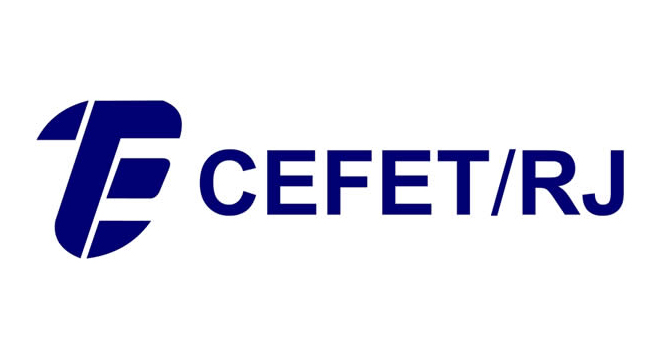1. INTRODUCTION
Stakeholders’ participation in forest governance plays an important role in forest resources management (Arnold, 2001; Sackey, 2007; Beaudoin et al., 2015; Shrestha and Shrestha, 2017; Overdevest and Zeitlin, 2018). Although an outsized number of studies exists which have documented stakeholder’s participation and involvement in forest resources management, further investigation remains needed so as to raised understand and supply more information on stakeholders participation in forest management at the grass root level (Marfo, 2004).
Participation in forest resources management refers to the active involvement of varied stakeholders (Nhem and Lee, 2019; Dobrynin et al., 2020; Eggers et al., 2020) in defining forest sector and conservation objectives, determining beneficiaries, managing forest resources, resolving conflicts over forest uses, and monitoring and evaluating the performance of forestry and biodiversity conservation projects (Roe et al., 2009; Elbakidze, et al., 2010). According to World Bank (1996), participation is “a process through which stakeholders’ influence and share control over development initiatives, decisions and resources which affect them”. Stakeholder participation was thus described as a process of institutional arrangements in which stakeholders are actively involved in different levels of management (including: decision making, planning activities, projects and programs designs) of forest resources.
Quite a number of forest plantations were established in Kwara State under Taungya System in the 1970s. one of such plantations was Odun Forest Reserve. During the early stage of the plantation, farmers were allowed to farm in the plantation thereby supporting food production. The reserve also provides vegetation cover and support environment. However, most of these forest reserves in the state are under high level of degradation. The degradation was as result of various level of depletion resulting from farming, over exploitation of the reserve for timber by timber contractor’s, frequent fire outbreak and other illegal activities.
According to the information provided by the Forestry Department under the Kwara State Ministry of Environment and Forestry, the last assessment in the reserve was carried out between 1976 and 1992. During this assessment, it was discovered that the vegetation cover of Aradun Forest Reserve has reduced. Continuous depletion is a threat to existence of the reserve and the associated biodiversity through habitat loss. Moreover, the benefits obtained by the people in sustaining their livelihoods will be cut off if the degradation continues.
Sustainable management of forest reserve is linked to participation of forest-dependent communities in the management and the utilization of benefits to improve livelihoods (Ghana Forestry Commission, 2009). Sustainable forest reserve is an integral component of development and cannot be isolated from the surrounding areas and communities. Therefore, forest reserve management has to be positioned in the context of development, especially where the forest reserve is situated (Ghana Forestry Commission, 2009).
The fundamental question, therefore, arises as to whether local communities participate in forest resources planning where important decisions are taken and, more importantly, what is the level of primary stakeholder’s involvement? Although a large number of studies exists which have documented stakeholders’ involvement in forest resources management, further investigation is still needed in order to better understand and provide detail information on stakeholders participation in forest management at the grass root level.
This study therefore assessesed stakeholders’ participation in Odun Forest Reserve, Arandun, Kwara State, Nigeria. The study was aimed at producing necessary information on stakeholders’ participation and their involvement in different process in the government own forest reserve, such as decision making, management and protection process as well as associated benefits of to their livelihoods. We envisaged that through effcetive participation, local development as a whole will enable realization of the goal of sustainable management of the reserve.
2. MATERIAL AND METHODS
The study was conducted in Odun
Forest Reserve, located beside Arandun community in Irepodun Local
Government Area of
southern region of Kwara State, Nigeria (Fig 1). Kwara State was often referred to
as the Gateway between the northern and southern parts of Nigeria. There were
thirty-two protected forest reserves, occupying a total area of 5.792 km2
or 17,82% of the total land area in the state. However, quite a number of these
reserves have been degraded while some have been totally lost to farming and
other infrastructural development. Odun Forest
Reserve is among the last standing reserve in the state and comprise of Tectona
grandis and Gmelina arborea. It is located at an elevation of 461
meters above sea level. The reserve occupies a total land area of about
203 hectares as at year 1976. However, due to high level of encroachment of
some farm-based practices by the community dwellers, it has been reduced to
about 76 hectares. Information obtained through reconnaissance survey revealed
that the reserve is faced with high level of encroachment, coupled with paucity of fund, inadequate patrol staff and
guards to the authority in charge.
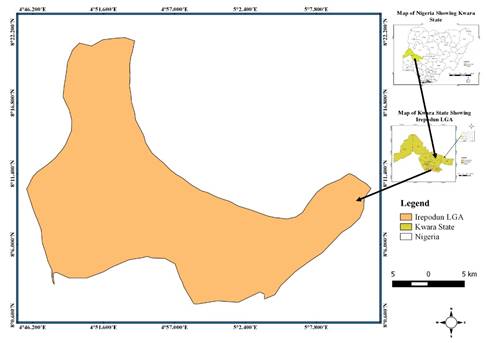 Figure 1
Location of
Irepodun Local Government Area
Figure 1
Location of
Irepodun Local Government Area
Due to lack of official documentation, information on establishment of Odun Forest Reserve obtained from key informant in the community. It was informed that the Reserve was initially a plantation of Teak which was established through Taungya system in 1976 alongside other plantations. It was established alongside other plantations at Ipetu and Olomu. All these plantations were later turned into Forest Reserves. The Teak plantations were established through Taungya system by foreign investors in partnership with the Department of Forestry. In the agreement, the foreign investors were to harvest the Teak on maturity for export after which they were handed over to the Forestry Department and turned into Forest Reserves. The trend in sizes of Odun Forest Reserve has drastically shrunk. The total area (2.03km2) of the established year (1976) of Odun Forest Reserve was intact till 1984 (2.03km2). In 1994, Odun Forest Reserve was reduced to 1.93km2. As at 1994, the size of the reserve was 1.92km2 and this was in line with the size reported by Babalola & Ajayi (2002). In 2005 and 2011, the total area of the reserve was reduced to 1.90km2. Furthermore, the size was 1.87km2 in 2015 and 1.84km2 in 2016.
The three major stakeholders selected for this study and their reasons for selection include the following: (a) Rural dwellers that reside in Arandun community and adjacent to Odun Forest Reserve (b) Timber contractor’s that directly involve in exploitation, processing and marketing of forest timber resources and (c) Kwara State Department of Forestry who are the official authority responsible for managing the reserve, controlling exploitation, as well as enforcement of regulation in the reserve.
Snowball sampling technique was adopted for sampling the respondents. Structured questionnaire was used for collection of primary data. The questionnaire was designed to generate data on the assessment of various levels of participation of the rural dwellers, timber contractor’s and the forestry official in the forest reserve, as well as socio and economic contributions of the forest reserve to the rural dwellers and the community development. Questionnaire administration to the timber contractor’s was carried out on their meeting days.
3. Review of Science
Governance in forest resources management includes structures and processes (Macura et al. 2011; Mansourian, 2017; Nansikombi et al., 2020). The expectation of the local authority and the requirement of the collaborative system approach is that the local people should fully participate in the implementation of forest activities. Studies done on collaborative management in Ghana by Asare (2000), Wily (2002) and Amanor (2003) reported that under the collaborative system approach, state forestry agencies have involved local people in management functions such as boundary cleaning, tree planting and establishment of firebreaks among others. They all reported that forest-dependent communities are also involved in curbing illegal activities such as illegal logging in forest reserve.
Kothari et al. (1998) stated that, apart from the local communities, the other stakeholders in the business of forest protection and use of forests are the State agencies that carry out the function of forest management, the urban dwellers, national/international communities, various NGOs, and other market and forest-based companies. The local communities according to Kothari et al. (1998), are the primary forest stakeholders because their livelihoods depend on forests. While the secondary forest stakeholders are being regarded as secondary forest stakeholders as they are not dependent on forest, they have alternative means of livelihood.
According to (Sophie, et al, 1999), the interest of stakeholders in forest management includes any of the functions of production, protection, harvesting, marketing, utilization, regeneration, development and conservation of forest resources. These interests are either complimentary or conflicting in terms of sustained supply of goods and services from the forests for the growing demands of forestry products. However, the socio-economic, cultural and political environments in which the stakeholders operate determine their interests. Byron (2006) informed that policy decisions are supposed to be made by government base on the best interests of their constituency. However, the best interest could only be obtained through dialogue with the concerned people by the Forest Department through the field officials.
While acknowledging the roles that central governments have played in the past as forest conservators (mainly through the creation of reserves), there is growing recognition that governments agencies have not ultimately proved the most effective agents for preserving forests. Even where forest entities have successfully managed the forests for conservation purposes, they have not always done so in a participatory manner (Kotey et al., 1998; Ganz et al., 2003).
4. RESULTS
Demographic
information of the sampled rural dwellers and timber contractors
Majority of the sampled rural dwellers (65%) and the timber contractor’s (85%) were male. The entire timber contractors (100%) were married and their tribe was Yoruba. On the other hand, 95% of the rural dwellers were married while 5% were single. On the level of education, 80% of the timber contractor and 60% of the rural dwellers went to primary school while 20% of the contractor and 35% of the rural dwellers attended secondary school as highest education. About 75% and 70% of the rural dwellers were indigenes of the community. For both categories of respondents 40% of their household size falls within the range of 1 to 5 while 6 to10 household sizes were 60%. The top three occupations of the people include farming (32,5%), trading (22,5%), and transport business (driver) (12,5%).
All the sampled timber contractors were members of timber association. Some of the benefits of joining the association include sharing of ideas, platform to gain contract, provision of financial assistance, conflict resolution, borrowing of equipment such as chainsaw from members.
Employment generated from Odun Forest Reserve to Rural Dwellers
As presented in Table
1, about 43,8% of the sampled respondents has benefited through employment
generated from Odun Forest Reserve to their household. The various benefits
include; workers (17,5%) in Odun Forest Reserve, (i.e. as a forest guard or as
a timber contractor on contract), Labourer (20,0%) to the timber contractors
(i.e. operators, drivers and those that help in lifting/carrying of logs into a
timber truck), workers (2,5%) in sawmill and as sellers of firewood or pole (3,8%)
obtained from the Reserve. According to these results, majority of the
stakeholders did not directly benefit from Odun Forest Reserve, but their
relation or family members who worked labourer with the timber contractors,
worker in sawmill, as well as sellers of firewood or pole obtained from Odun
forest reserve. Lise (2000) and Maskey et al. (2003) reported that the extent
of area people participation is decided by the advantages obtained from forests
or high dependency on forest or good forest quality. They argued that when
people’s dependency on forests is high, their interest in forests is likely to
be greater, inducing people to participate in forest management and protection
activities.
Table 1
Employment generated from Odun Forest
Reserve to Rural Dwellers
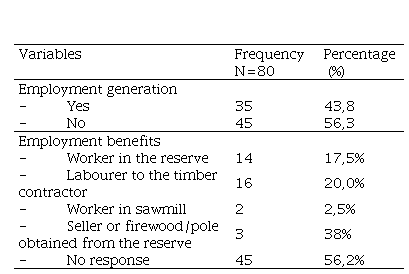
|
Variables
|
Frequency
N=80
|
Percentage
(%)
|
|
Employment generation
| | |
|
-
Yes
|
35
|
43,8
|
|
-
No
|
45
|
56,3
|
|
Employment benefits
| | |
|
-
Worker in the reserve
|
14
|
17,5%
|
|
-
Labourer to the timber
contractor
|
16
|
20,0%
|
|
-
Worker in sawmill
|
2
|
2,5%
|
|
-
Seller or firewood/pole
obtained from the reserve
|
3
|
38%
|
|
-
No response
|
45
|
56,2%
|
Product collection and payment of
levy from Odun Forest Reserve by the rural people
As
presented in Table 2, 31,3% of the sampled rural people collected products from
the forest reserve. The major product collected includes firewood (26,3%) while
26,3% collected leaves. Only 18,8% paid levies to collect products from the
reserve while majority did not pay levies. These products are mainly used at
domestic level and only collected during the harvesting of trees. The rural
people used the leaves collected from the reserve for rapping of kola-nuts
while the firewood was used as a source of energy for domestic cooking and as a
source of income to households. The reason why majority of the people indicated
that they did not pay levy was that dead and dry branches which drops from the
standing trees or left as cut off after harvesting were collected in the
reserve. These dry wood are popularly known as “Igi gbigbe” in Yoruba and
literally means “Dry wood” in English. Sometimes, the dry wood may be collected
and used during ceremonies such as burials, marriages and other ceremonies in
the community.
Table 2
Product collection and payment of levy from Odun Forest Reserve
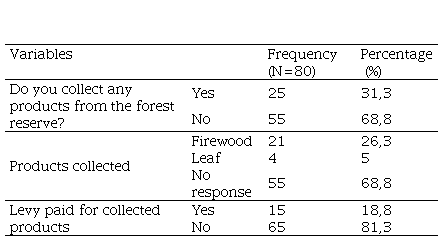
|
Variables
| |
Frequency (N=80)
|
Percentage (%)
|
|
Do you collect any products from the forest reserve?
|
Yes
|
25
|
31,3
|
|
No
|
55
|
68,8
|
|
Products collected
|
Firewood
|
21
|
26,3
|
|
Leaf
|
4
|
5
|
|
No response
|
55
|
68,8
|
|
Levy paid for collected products
|
Yes
|
15
|
18,8
|
|
No
|
65
|
81,3
|
According to Abi-Ene (2013), the members of the adjoining community forest in Cross River State obtain forest resources to sustain their livelihoods. The situation in Cross River State is quite different from Kwara State because of the ownership structure on the reserves. In Cross River State where the forest is jointly owned by the communities, people are allowed to enter the forest for collection of resources which are jointly owned. However, in Odun Forest Reserve, the forest is owned by the State, hence with high level of regulation with respect to collection of resources within the reserve.
Furthermore, Monsi (2014) also reported that wood collected from reserve in Cameroon was used as fuel for cooking, heating homes, and as a source of light, just to name a few. Since most of the people in rural areas are poor or living below the poverty line, they can hardly afford for electric or gas stoves, thus, they rely greatly on wood for meeting their energy needs. Collection of fuel wood can also be a major driver of deforestation at local level (Fao, 2010) and thus may affect the health of the forest if harvesting is not sustainable.
As discovered in the study area, majority of the respondents did not pay any levy before they can harvest firewood and leaves from the forest reserve. Those that paid levy for collecting firewood in the community informed that they paid undocumented rate of N20 per bundle, to the forest guard in charge and the leaves collected are for free.
As informed, felling of trees by unauthorized individual is not permitted in the reserve. Only those with due permission after obtaining necessary permit and making payment are allowed to carry out felling operation under supervisions. However, the community is allowed to carry out felling of trees needed for major community projects such as constructions of buildings like town halls. However, the King will have to request for permission for such felling to take place. In addition, some influential people, who are also close to the King, in the community may sometimes use their positions to make request for harvesting of some trees to be used for personal purposes in the reserve.
The results of the survey indicated that majority of the respondents in the timber contractors’ association neither collect nor harvested any other products aside felling of mature trees in the reserve. However, they all obtain necessary permit and paid appropriate levies prior to carrying out of the felling of trees in the reserve. In another study carried out by Abi-Ene (2013) in Cross River State, the entire timber dealers confirmed that they purchased their timber from sustainably managed forest and also paid levies for felling of trees in the community forest.
The sampled respondents reported that, the levies for felling from the forest reserve are paid to the Department of Forestry. Abi-Ene (2013) reported that, the levies paid in Cross River State are in two categories; ‘the State Forestry Commission’ through extraction permit and to the ‘community leaders’ for carrying out felling operations on the communal land. This means that levies are mostly paid to carry out felling operations in public forests. Findings from the survey showed that the timber contractors pay stumpage prices for felling of mature trees, harvested from Odun Forest Reserve. For instance, the stumpage price for Gmelina arborea cost N800 while for Tectona grandis cost N550, per stand. They also reported that there are other levies paid to the Government, which are Revenue fee and Evacuation fee.
Participation of community and timber contractor’s in
management of Odun Forest Reserve
Table 3 shows that majority of
the rural dwellers did not participate in the decision making (87,5%), as well
as in prevention of illegal exploitation (80%) and in Odun Forest Reserve. On
the contrary, only 45% of the sampled timber contractors participated in the
decision making process of the reserve with the Forestry Departments, while all
the contractors indicated that they participated in prevention of illegal
exploitation.
Table 3
Participation in decision making and prevention of
illegal exploitation by rural dwellers and timber contractors
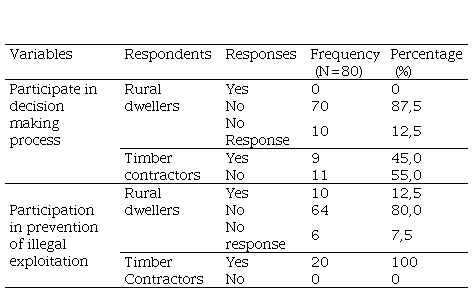
|
Variables
|
Respondents
|
Responses
|
Frequency
(N=80)
|
Percentage
(%)
|
|
Participate in
decision making process
|
Rural
dwellers
|
Yes
|
0
|
0
|
|
No
|
70
|
87,5
|
|
No
Response
|
10
|
12,5
|
|
Timber
contractors
|
Yes
|
9
|
45,0
|
|
No
|
11
|
55,0
|
|
Participation
in prevention of illegal exploitation
|
Rural
dwellers
|
Yes
|
10
|
12,5
|
|
No
|
64
|
80,0
|
|
No
response
|
6
|
7,5
|
|
Timber Contractors
|
Yes
|
20
|
100
|
|
No
|
0
|
0
|
Table 4 shows the level of
participation of the contractors in the protection process of Odun Forest
Reserve. It could be observed that only 35% of the contractors indicated that
they participated in fire control of the reserve, while 85% participated in
reporting of fire incidences, and boundary fire
tracing (50%). Meanwhile, majority all the contractors indicated that they
participated in reporting illegal and/or unauthorized felling of logs (100%)
and patrol protection process (100%) in the reserve.
Table 4
Participation of Timber contractors in Odun Forest Reserve protection
process
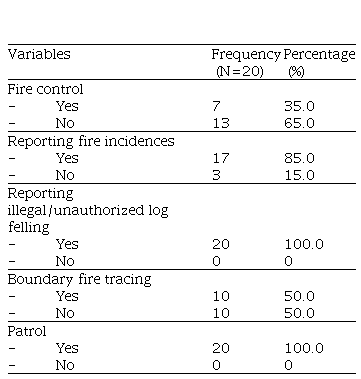
|
Variables
|
Frequency (N=20)
|
Percentage (%)
|
|
Fire control
| | |
|
-
Yes
|
7
|
35.0
|
|
-
No
|
13
|
65.0
|
|
Reporting fire incidences
| | |
|
-
Yes
|
17
|
85.0
|
|
-
No
|
3
|
15.0
|
|
Reporting illegal/unauthorized log felling
| | |
|
-
Yes
|
20
|
100.0
|
|
-
No
|
0
|
0
|
|
Boundary fire tracing
| | |
|
-
Yes
|
10
|
50.0
|
|
-
No
|
10
|
50.0
|
|
Patrol
| | |
|
-
Yes
|
20
|
100.0
|
|
-
No
|
0
|
0
|
According to Sophie, et al, (1999), the interest of stakeholders in forest management includes any of the functions of production, protection, harvesting, marketing, utilization, regeneration, development and conservation of forest resources. These interests are either complimentary or conflicting in terms of sustained supply of goods and services from the forests for the growing demands of forestry products. However, the socio-economic, cultural and political environments in which the stakeholders operate determine their interests.
Although, the stakeholders are invited to meeting with the Forestry Department, however they were not properly involved in taking management decision on the reserve. Whenever an invitation was sent to the timber contractors for attendance in a meeting, representative(s) is/are normally selected during meeting of the Timber Contractors’ Association. At the meeting with the Forestry Officials, representative selected by the contractors do not normally have a say, but rather served as an observer during discussions relating to the forest reserve. Feedbacks from the meetings are delivered to the Association, and presented to the entire house during the contractors’ meetings. Byron (2006) informed that policy decisions are supposed to be made by government base on the best interests of their constituency. However, the best interest could only be obtained through dialogue with the concerned people by the Forest Department through the field officials.
In the same vein, the results of the survey indicated that majority of the rural dwellers does not participate in the decision making relating to Odun Forest Reserve. According to Abi-Ene (2013), for effective participation in community-based forestry, empowerment of local people in decision-making process has been identified to be very crucial. In addition, achievement of the main objectives of sustainable forest management is based on involvement of the necessary stakeholders in carrying out some responsibilities such as forest protection and decision-making process.
Furthermore, Macura et al. (2011) state that system of governance in forest resources management includes structures and processes, through which partners make and implement decisions and distribute power. The expectation of the local authority and the requirement of the collaborative system approach is that the local people should fully participate in the implementation of forest activities. This would help local people to understand their responsibilities, benefit and obligations under co-management approach (Wily, 2002; Borrini-Feyerabend et al., 2004). The major roles mentioned by the forest-dependent people were tree planting and management in admitted farms in the reserve, boundary cleaning, reporting of illegal activities and responding to emergency wildfire outbreak. The minor roles mentioned were facilitation of Social Responsibility Agreement (SRA) and refraining from illegal activities. Findings from similar studies confirm that stakeholders have been involved in similar forest resources implementation activities. For instance, studies done on collaborative management in Ghana by Asare (2000), Wily (2002) and Amanor (2003) reported that under the collaborative system approach, state forestry agencies have involved local people in management functions such as boundary cleaning, tree planting and establishment of firebreaks among others. They all reported that forest-dependent communities are also involved in curbing illegal activities such as illegal logging in forest reserve.
5. CONCLUSION
The study assessed participation of stakeholders in management of Odun Forest Reserve located in Kwara State Nigeria. The reserve is under the management of the Department of Forestry, but provides some socio-economic benefits to the livelihood of rural dwellers in adjacent Aradun community and timber contractors. The major product obtain from the reserve was timber, leaves and firewood. Be as it may, the stakeholders’ participation in management of this government owned forest reserve was very low, especially in decision making process.
To facilitate sustainable management of the reserve, concerted efforts are required by the Forestry Department to involve the local stakeholders in management of the reserve. Local stakeholders should be allowed to participate in decision making process of the reserve. This will give the stakeholders the sense of ownership necessary for sustainability and protection against illegal activities. Also, payment of levies to collect products from Forest Reserves should be properly regulated. It is important that boundary of the reserve be properly maintained to prevent further encroachment and effective patrol. Due to the vast area of Odun Forest Reserve, more forest guards should be employed for enough patrols.
6. REFERENCES
Abi-Ene, A. (2013). Participation of forestry officials and timber dealers in community-based forestry in cross river state, Nigeria. International Journal of Research In Social Sciences 3(2), 21-32. http://www.ijsk.org/uploads/3/1/1/7/3117743/3_forest_management.pdf
Amanor, K. S. (2003). Natural and Cultural Assets and Participatory Forest Management in West Africa. International Conference on Natural Assets, Tagaytay, the Philippines. Conference paper series No. 8. 8-11 January 2003, pp 12-26.
Arnold, (2001). Forests and people: 25 years of Community Forestry. Food and Agriculture Organization of the United Nations. Rome.134pp
Asare, A. (2000). Community Involvement in Natural Resources Management. The Experience of Ghana Forestry Department.
Babalola, F. D., & Ajayi, C. A. (2002). Forest policy review: implication for sustainable forest management in Kwara state Nigeria. Obeche Journal. 24 (1), 44-55.
Beaudoin, J. M., Bouthillier, L., & Chiasson, G. (2015). Growing deep roots: Increasing Aboriginal authority in contemporary forest governance arrangements. Land Use Policy, 49, 287-295. https://doi.org/10.1016/j.landusepol.2015.08.004
Borrini-Feyerabend, G., Pimbert, M., Farvar, M. T., Kothari, A. & Yves, R. (2004). Sharing Power-learning by Doing in Co-management of Natural Resources throughout the World. IIED and IUCN/CEESP. https://doi.org/10.1111/j.1477-8947.2008.00194.x
Byron, N., (2006). Challenges in defining, implementing and renewing forest policies. In: Perlis, A. (ed.) Unasylva - No. 223. An international journal of forestry and forest industries. FAO - Food and Agriculture Organization of the United Nations
Dobrynin, D., Smirennikova, E., & Mustalahti, I. (2020). Non-state forest governance and ‘Responsibilization’: The prospects for FPIC under FSC certification in Northwest Russia. Forest Policy and Economics, 115, 102142. https://doi.org/10.1016/j.forpol.2020.102142
Eggers, J., Räty, M., Öhman, K., & Snäll, T. (2020). How Well Do Stakeholder-Defined Forest Management Scenarios Balance Economic and Ecological Forest Values?. Forests, 11(1), 86. https://doi.org/10.3390/f11010086
Elbakidze, M., Angelstam, P. K., Sandström, C. and Axelsson. R., (2010). Multi-stakeholder collaboration in Russian and Swedish Model Forest initiatives: adaptive governance toward sustainable forest management?. Ecology and Society, 15(2), 14. [online] URL: http://www.ecologyandsociety.org/vol15/iss2/art 14/
FAO (2010). Forestry Resource Assessment, and the State of World’s Forests.
Ganz, D., Moore, P., & Reeb, D. (2003). Community-Based Fire Management Case Studies from China, The Gambia, Honduras, India, Lao People’s Democratic Republic and Turkey. FAO Forestry Report.
Ghana Forestry Commission, (2002). Draft Report on Socio-Economics Survey of Forest Fringe Communities for Participatory Forest Management. Chase Hills Forest Reserve in the Navrongo Forest District, Upper East region, Ghana.
Kotey E. N. A., Francois J., Owusu J. G. K., Yeboah R., Amanor K. S., & Antwi, L. (1998) Falling into place. Ghana policy that works for forests and people series no 4, IIED, London, UK.
Kothari, A., Anuradha, R.V. & P. Neema (1998). Community – Based Conservation: Issues and Prospect. In: Kothari et al. communities and conservation. Natural Resource Management in South and Central Asia. Sage Pub. Ltd. New Delhi, India.
Lise, W. (2000). Factors Influencing People’s Participation in Forest Management in India. J. Ecol. Econ., (34), 379-392. https://doi.org/10.1016/s0921-8009(00)00182-8
Macura, B., Zorondo-Rodríguez, F., Grau-Satorras, M., Demps, K., Laval, M., Garcia, C. A. & Reyes-Garcia, V., (2011). Local community attitudes toward forests outside protected areas in India. Impact of legal awareness, trust, and participation. Ecology and Society 16(3), 10. https://doi.org/10.5751/ES-04242-160310
Mansourian, S. (2017). Governance and forest landscape restoration: A framework to support decision-making. Journal for Nature Conservation, 37, 21-30. https://doi.org/10.1016/j.jnc.2017.02.010
Marfo, E. (2004). Unpacking and Repacking Community Representation In Forest Policy and Management Negotiations: Lessons from The Social Responsibility Agreement in Ghana. Ghana Journal of Forestry, 15&16(2004), 20-29. https://doi.org/10.4314/gjf.v15i1.36898
Maskey, V., Gebremedhin, T. G., & Dalton, J. (2003). A survey of analysis of participation in a community forest management in Nepal, paper presented at the Northeastern Agricultural Resource Economics Association, Portsmouth, New Hampshire, and June 8-10.
Monsi, N. I. (2014). Communities ’ role in sustainable forest management in cameroon : managers or participants ? Ritsumeikan asia pacific university.
Nansikombi, H., Fischer, R., Kabwe, G., & Günter, S. (2020). Exploring patterns of forest governance quality: Insights from forest frontier communities in Zambia´ s Miombo ecoregion. Land Use Policy, 99, 104866. https://doi.org/10.1016/j.landusepol.2020.104866
Nhem, S., & Lee, Y. J. (2019). Women’s participation and the gender perspective in sustainable forestry in Cambodia: local perceptions and the context of forestry research. Forest Science and Technology, 15(3), 93-110. https://doi.org/10.1080/21580103.2019.1595174
Overdevest, C., & Zeitlin, J. (2018). Experimentalism in transnational forest governance: implementing european union forest law enforcement, governance and trade (FLEGT) voluntary partnership agreements in Indonesia and Ghana. Regulation & Governance, 12(1), 64-87. https://doi.org/10.1111/rego.12180
Roe D., Nelson, F., Sandbrook, C. (eds.) (2009). Community management of natural resources in Africa: Impacts, experiences and future directions, Natural Resource Issues No. 18, International Institute for Environment and Development, London, UK.
Sackey, A. N. A. (2007). Assessment of Forest Management Practices in Ghana: A Case Study of Some Forest Districts in Ghana (Abstract). The IMRE Journal, 1(2).
Shrestha, S., & Shrestha, U. B. (2017). Beyond money: Does REDD+ payment enhance household's participation in forest governance and management in Nepal's community forests?. Forest Policy and economics, 80, 63-70. https://doi.org/10.1016/j.forpol.2017.03.005
Sophie, H., Bass, S., Judd, N., Mayers, J. and Nussbaum, R. (1999). The Sustainable Forestry Hand Book. London: EarthScan. 289pp.
Wily, L.A. (2002). Participatory Forest Management in Africa. An Overview of Progress and Issues. Community Based Natural Forest Management Network (CBNM). http://www.cbnrm.net/pdf/aldenwily_l_002_cfm.pdf
World Bank (1996). The World Bank participation sourcebook. Washington, DC. (www.worldbank.org/wbi/sourcebook/sba204.htm) (Accessed 05/12/2008, 5: 06 GMT).
Appendix
DECLARATION OF
CONTRIBUTIONS TO THE ARTICLE - CRediT
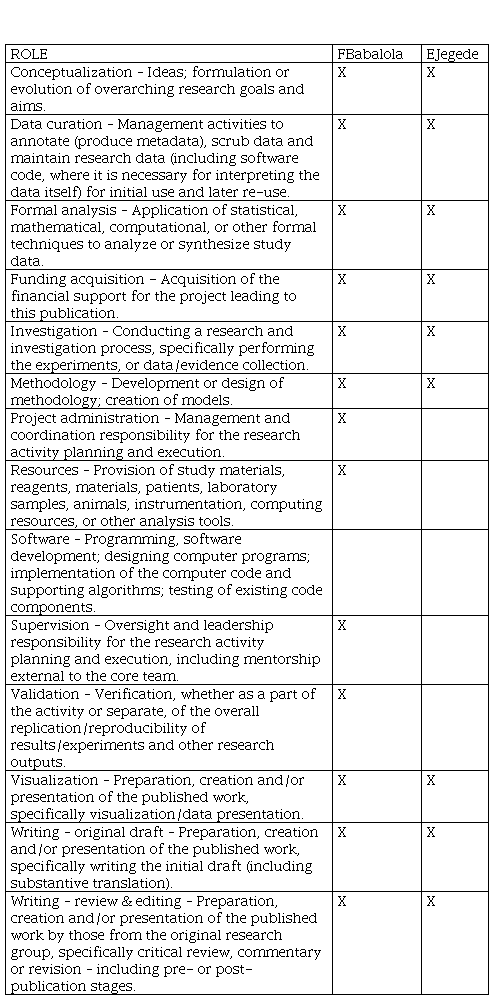
|
ROLE
|
FBabalola
|
EJegede
|
|
Conceptualization
– Ideas; formulation or evolution of overarching research goals and aims.
|
X
|
X
|
|
Data curation –
Management activities to annotate (produce metadata), scrub data and maintain
research data (including software code, where it is necessary for
interpreting the data itself) for initial use and later re-use.
|
X
|
X
|
|
Formal analysis
– Application of statistical, mathematical, computational, or other formal
techniques to analyze or synthesize study data.
|
X
|
X
|
|
Funding
acquisition - Acquisition of the financial support for the project leading
to this publication.
|
X
|
X
|
|
Investigation –
Conducting a research and investigation process, specifically performing the
experiments, or data/evidence collection.
|
X
|
X
|
|
Methodology –
Development or design of methodology; creation of models.
|
X
|
X
|
|
Project
administration – Management and coordination responsibility for the research
activity planning and execution.
|
X
| |
|
Resources –
Provision of study materials, reagents, materials, patients, laboratory
samples, animals, instrumentation, computing resources, or other analysis
tools.
|
X
| |
|
Software –
Programming, software development; designing computer programs;
implementation of the computer code and supporting algorithms; testing of
existing code components.
| | |
|
Supervision –
Oversight and leadership responsibility for the research activity planning
and execution, including mentorship external to the core team.
|
X
| |
|
Validation –
Verification, whether as a part of the activity or separate, of the overall
replication/reproducibility of results/experiments and other research
outputs.
|
X
| |
|
Visualization –
Preparation, creation and/or presentation of the published work, specifically
visualization/data presentation.
|
X
|
X
|
|
Writing –
original draft – Preparation, creation and/or presentation of the published
work, specifically writing the initial draft (including substantive
translation).
|
X
|
X
|
|
Writing –
review & editing – Preparation, creation and/or presentation of the
published work by those from the original research group, specifically
critical review, commentary or revision – including pre- or post-publication
stages.
|
X
|
X
|
